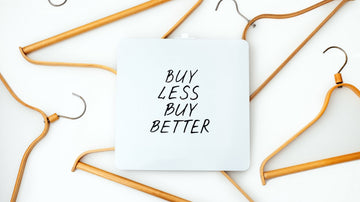Have you ever gone to one of those fast-fashion stores, purchased something, and after one wash realized you've thrown away your money? Personally, I'd rather spend more money on a high quality garment that I can love for seasons to come, than waste my money on a throw away garment that will end up in a landfill far too soon.
In a world of fast-paced trends and fleeting fashion fads, there's a movement gaining momentum—one that emphasizes quality, sustainability, and a conscious approach to clothing. This is the world of slow fashion, where timeless style meets ethical production practices. In this blog post, we'll explore the importance of slow fashion and how it is transforming the way we view and interact with our wardrobes.
Understanding Slow Fashion
Slow fashion is more than just a trend; it's a mindset shift towards a more thoughtful and responsible way of consuming fashion. It encourages us to question the prevailing "buy, wear, discard" culture and instead embrace garments that are designed to last, made with sustainable materials, and produced under fair working conditions.
Quality over Quantity
One of the core principles of slow fashion is the focus on quality over quantity. Instead of purchasing cheap, disposable clothing that quickly falls apart, slow fashion encourages investing in well-made garments that are durable and designed to withstand the test of time. By choosing quality pieces, we not only reduce waste but also save money in the long run.
Ethical and Transparent Production
Slow fashion advocates for transparency throughout the entire supply chain. It encourages brands to embrace fair labor practices, ensuring that workers involved in the production process are treated ethically and paid a fair wage. By supporting brands that prioritize ethical production, we contribute to a more equitable and sustainable fashion industry.
Minimizing Environmental Impact
The fast fashion industry is notorious for its negative environmental impact, from excessive water consumption to pollution caused by toxic chemicals. Slow fashion, on the other hand, champions sustainable materials, such as organic cotton, hemp, and recycled fabrics, which have a lower environmental footprint. By choosing eco-friendly materials and supporting brands with sustainable practices, we can help mitigate the environmental damage caused by the fashion industry.
Rediscovering Personal Style
In a world of mass-produced fashion, slow fashion encourages us to rediscover our personal style. By investing in timeless, versatile pieces that align with our values and aesthetic preferences, we can curate a wardrobe that truly reflects our individuality. Slow fashion embraces creativity and individual expression, empowering us to break free from the cycle of trends and find joy in clothing that resonates with our authentic selves.
Building a Circular Economy
Slow fashion promotes the concept of a circular economy, where garments are designed to be recycled, upcycled, or repurposed at the end of their lifecycle. By embracing this approach, we can extend the lifespan of our clothing, reduce waste, and contribute to a more sustainable future.
The rise of slow fashion represents a powerful shift towards a more conscious and sustainable approach to clothing. By embracing quality over quantity, supporting ethical production, and minimizing our environmental impact, we can contribute to a more equitable and environmentally friendly fashion industry.




